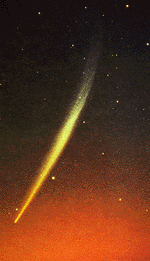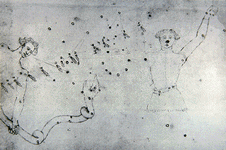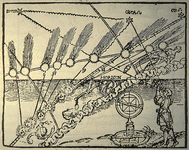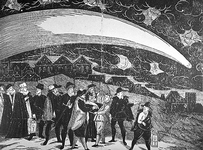
 |
| Comet Ikeya-Seki |
Comets
Comets played an important role in the revolution of astronomy and cosmology that occurred between 1500 and 1700. In the earlier Aristotelian geocentric cosmological scheme, the universe was divided into two regions with very different characteristics. The heavens, which reached from the sphere of the Moon to that of the fixed stars, were perfect and unchanging; motion there was exclusively circular. Below the Moon was the world of corruption and change. The Earth was the center of the universe, the natural place of all heavy bodies (bodies in which the element earth predominated). Around it were arranged in successive spherical shells the elements of water, air, and fire. The sphere of fire reached up to the sphere of the Moon, the first heavenly sphere. Although there are references in Aristotle that some of the imperfection of the sublunary region may have rubbed off on the Moon, basically the divide between the heavenly and sublunary regions was absolute.
If the heavens were perfect and unchanging, then no change could occur in them. Any phenomenon that involved change was, therefore, by definition a sublunary one. Whereas heavenly bodies moved around the Earth in never ending circles, repeating their patterns over and over, comets came and went. They appeared suddenly, moved across the constellations for a brief period of time, and then disappeared. There was no regularity, no pattern to their appearances and motions. They were therefore considered changing appearances and therefore by definition their location was "below" the Moon. (It is to be noted here that this is true only in western cosmology after Aristotle. In the cosmologies of other cultures, comets were defined differently.)
The Aristotelian cosmology was dominant in the Islamic world and in Christian Europe. We find no coherent record of comets in the astronomical annals of these cultures (as we do, for instance in China). Comets were, of course, observed, and they are mentioned in chronicles and other non-astronomical documents. They were considered omens, bad omens, and since there was always a major disaster (plague, war, flood, fire, etc.) that happened shortly after a comet had been seen, there was no easy way to prove this notion wrong.
 |
| Comet of 1449-50 observed
by Toscanelli [click for larger image] |
The first recorded efforts to study the paths of comets across the heavens as an astronomical exercise occurred in Florence in the fifteenth century, about a century before the birth of Galileo. By the early sixteenth century, astronomers were observing and measuring the positions of all comets, and in the 1530s Peter Apian in Germany discovered that the tail of a comet always points away from the Sun. His discovery was illustrated in a tract written in German, meant for popular consumption. Among the philosophers (and cosmology was a part of philosophy) there was as yet no doubt that comets were sublunary phenomena.
 |
| Comet of 1532 observed
by Apian [click for larger image] |
But practicing astronomers, that is those who observed the positions of heavenly bodies and calculated their positions, increasingly began to measure the positions of comets. If they were below the Moon, then their parallax could be no less than the Moon's, about 1° (the horizontal parallax, which is the angle subtended at the Moon by the Earth's radius). Why did not a few carefully executed measurements settle this issue quickly?
First, there was in Europe no great tradition of making accurate, or even regular, astronomical observations before about 1500. For that reason, measuring instruments were primitive, not even taking advantage of the capabilities of existing technology. They were simple, hand-held, wooden instruments--little more than roughly calibrated sticks--and their accuracy was perhaps at best 1/4°, usually perhaps 1/2°. There was little accuracy and even less consistency in the measurements of individual astronomers. When it came to comparing the measurements of practitioners in places all over Europe, the situation became hopeless. The results were parallaxes ranging from 10° to negative values.
Second, astronomers and others who practiced the mathematical sciences dealt only with positions and motions. These were accidental properties of bodies and could tell you nothing about their essences. A mathematician could tell you where the apple was and he could describe its motion if it fell. But this information could not tell you what made this body an apple and why it fell. These were questions that belonged to philosophy. It was therefore not at all obvious that the measurements of the astronomers could turn an obviously changing cometary phenomenon into a perfect and immutable heavenly body.
 |
| Comet of 1577 [click for larger image] |
By the time Galileo was beginning to turn his attention to the study of mathematics, the science of astronomy was changing. Copernicus's De Revolutionibus (1543) had been around for a generation, and there were other cosmological theories as well that challenged the existing cosmology. When in 1577 a huge comet appeared whose tail spread in a great arc across the sky, observers all over Europe, Tycho Brahe among them, made measurements of its changing positions. The resulting literature was huge, and if the verdict was by no means unanimous, it was clear that the opinion that comets were heavenly bodies had become respectable in learned circles. The rising authority of Tycho Brahe, based on his noble birth and his miraculous instruments, gave added impetus to the change of opinion. Over the next two generations the perfection of the heavens was abandoned, as were the crystalline spheres of which they were supposedly composed.
 |
| Comet of 1618 [click for larger image] |
But placing comets in the heavens raised new questions. What were their paths? What was their nature? Through much of the seventeenth century the debate ranged. in his Assayer of 1623 Galileo argued that comets were optical phenomena and that therefore one could not measure their parallaxes. In this opinion he was not followed by others. It was argued that comets moved in straight lines or parabolic arcs. Descartes argued that comets were bodies that traveled from one solar system to another.
The mechanical philosophy of the second half of the seventeenth century had a great bearing on this debate, as we can see in Isaac Newton's conclusions. In his Mathematical Principles of Natural Philosophy of 1687, Newton argued that all matter attracts all other matter. If comets are made of matter, then they are attracted to the Sun just as the planets are. Given rectilinear inertia and a centrally directed force, the moving body's path must be a conic section. Edmond Halley took this notion and drew up a table of the parameters of the twenty-odd brightest comets that had been seen over the previous several centuries. He pointed out that the parameters of the comets of 1533, 1607 and 1682 were the same and concluded that this was a periodic comet. He predicted its return in 1758. In that year (Halley had died in 1742) the comet appeared as predicted and has been called Halley's Comet ever since.
By the beginning of the eighteenth century, then, comets had been brought under the category of phenomena that obey natural laws. But these laws were those of the new physics and astronomy, not those of Aristotelian physics and Ptolemaic cosmology.
Sources: The standard treatment of the comet of 1577 is C. Doris Hellman, The Comet of 1577: Its Place in the History of Astronomy (New York: AMS Press, 1971. For considerations of earlier comets see Jane L. Jervis, Cometary Theory in Fifteenth-Century Europe (Wroclaw: Ossolineum, The Polish Academy of Sciences Press, 1985). See also Victor E. Thoren, "The Comet of 1577 and Tycho Brahe's System of the World," Archives Internationales d'Histoire des Sciences , 29 (1979):53-67. Several good books on comets and their history were published for the 1985/6 appearance of Halley's comet. I recommend Robert D. Chapman and John C. Brandt, The Comet Book: A Guide for the Return of Halley's Comet (Boston and Portola Valley: Jones and Bartlett, 1984), and Carl Sagan and Ann Druyan, Comet (New York: Random House, 1985).
Images:
Top Picture: Comet Ikeya-Seki, 29 October 1965. Picture by C. R. Lynds, Kitt Peak National Observatory, Tucson.
Comet of 1449-50 observed by Toscanelli: taken from Jane L. Jervis, Cometary Theory in Fifteenth-Century Europe (Dordrecht: D. Reidel, 1985), p. 79. The original manuscript is Biblioteca Nazionale di Frienze, Banco Rari 30, f. 250r.
Comet of 1532: Peter Apian, Ein kurtzer bericht d'Observation unnd urtels des Jüngst erschinnen Cometen im weinmon und wintermon dises XXXII. Jars (Ingolstadt, 1532).
Comet of 1577: Woodcut by Jiri Daschitzsky, Von einem Schrecklichen und Wunderbahrlichen Cometen so sich den Dienstag nach Martini M. D. Lxxvij. Jahrs am Himmel erzeiget hat (Prague (?): Petrus Codicillus a Tulechova, 1577).
Comet of 1618: From Gothard Arthusius, Cometa Orientalis, Kurtze unde eigenlichen Beschreibung des neuen Cometen so im November des abgelauffenen 1618. Jarhs in Orient oder gegen Auffgang der Sonnen allhie erschienen und von menniglich gesehen worden (Frankfurt a. M., 1619.
Last updated
Science | Christianity | Library | About | Site Map | Search
Please note: We will not answer copyright requests.
See the copyright page for more
information.










